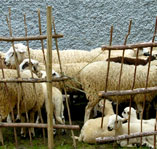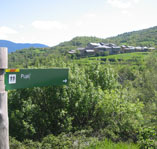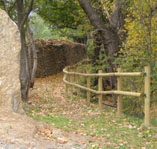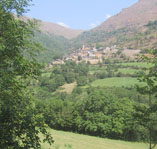



|
The flora of El Pallars Sobirà, its natural areas, is similar to other parts of the Catalan high mountain, as the fauna commonly associated to the county. Those are species perfectly adapted to the cold, as for instance, the ptarmigan, the chamois and the ermine, which belong to the Alpine stage.
Further down the mountainside, on the sub Alpine stage, one can find species that belong to the forest (some of them threatened with extinction), such as the capercaillie, the Pyrenean little owl, a variety of woodpeckers, the roe deer, the fallow deer and some other more that can be seen on a lucky day. As a matter of fact, the biggest population of capercaillie of the state is found in this county due to the large amount of Scotch pine, and fir forestlands. Many regions in these forests have sheltered as well the brown bears of the Pyrenean mountain range.
On the sunny slopes, the established fauna are the partridge, the hare, the wild boar and the deer, among others. These are usually found among the laburnum, the rhododendron and other bushes; the same habitat is shared with an important amount of bird species and flesh eating mammals of middle size.
On the mountain stage, very close to the areas where people still lives, the deciduous forests and the winter grazes and meadows- becoming more and more scarce every season_ will be the typical habitat for species from the centre of Europe, such as the bullfinch and the yellow-hammer, among others.
In the rivers and clean water lakes (very abundant and characteristic from El Pallars), the common trout, the dipper and the otter still subsist.
Finally, the population of predatory birds, such as the vulture, the indigenous bearded vulture and the golden eagle will fly above the summits searching some food.
FAUNA ITINERARIES IN THE TOWNSHIP OF SORT
Itinerary of the Valley of Àssua
In 2000, the first fauna guide book of El Pallars Sobirà was published, sketching out 11 itineraries, the longest one in the township of Sort, travelling across the different natural environments of the Valley of Àssua (Bago de Llessui-sheds of Llessui-Mainera Lake), one of the valleys with a most important agricultural and livestock breeding tradition in the whole region. Among the best-known fauna are the red-legged partridge, the grey partridge, the quail, the golden eagle, the bearded vulture, the griffon vulture, the chamois, the rock ptarmigan, the fox, the hare...
Route of the butterflies in the Bailiwick of Sort:
The Butterfly Museum of Catalonia has been studying, from the first moment on its opening date in July 2002, the area of the Bailiwick of Sort, where the museum is set. In this not-so-extensive area, we have discovered more than a hundred daytime butterflies of about the two hundred ones living in Catalonia. To spread this information, the“Route of the butterflies” has been organised to see the majority of them flying, each in its time and proper place. To inform visitors, there are signposts and information stand with indications about ten species and indications of the habitats, time and nutritional plants. It is a first step to spread knowledge about the world of nature and its relationships, starting from butterflies and insects, animals playing an essential role in natural processes and encouraging life in the planet. These are an exceptional, natural and didactic complement to the facts about butterflies and insects, their relation to plants and to other animals, including humans, which will be found in the information and examples exhibited in the Museum. This is another incentive to visit the area and the Butterfly Museum of Catalonia, with the certainty that, when leaving and seeing the richness around us, we will be able to understand more about biodiversity, understanding how and why they work as they do, why we have to respect it; we will become more "Homo" and more "sapiens".
Butterfly Museum of Catalonia (www.papallones.net). Contact telephone 973620743
|